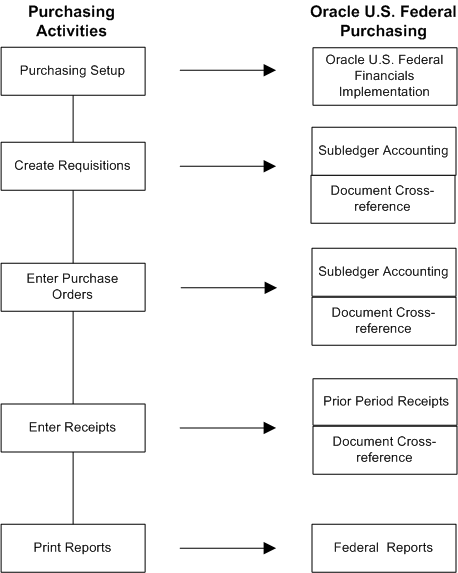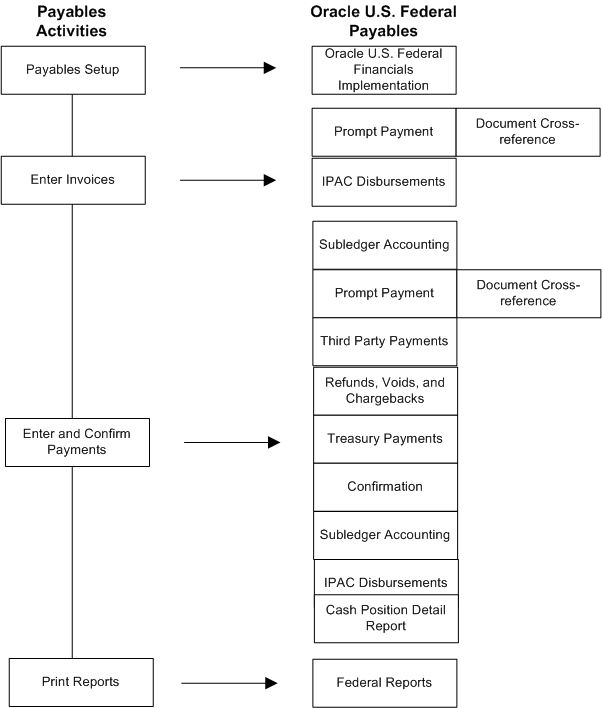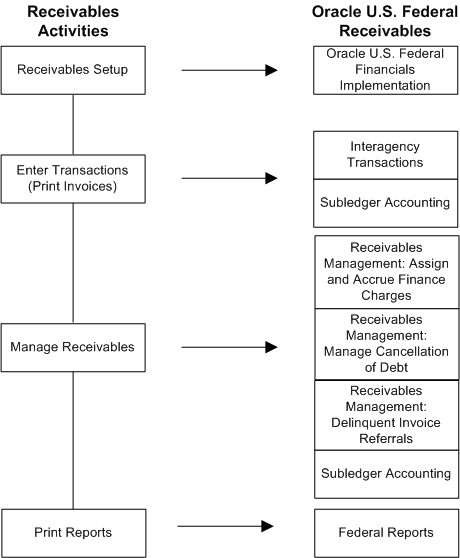Product Overview
Overview
Oracle U.S. Federal Financials provides the basis for an integrated financial management solution for federal agencies, providing features such as budgetary control, fund accounting, online funds checking, cost accumulation and allocation, United States Standard General Ledger (US SGL) accounts, Treasury cash accounts, regulatory and ad hoc reporting, multiple fund receivables accounting, and multiple organization capabilities.
Oracle Public Sector Financials Modules in Oracle U.S. Federal Financials Diagram
This diagram shows Oracle Public Sector Financials modules that are affected by or enhanced in Oracle U.S. Federal Financials. General Ledger activities are described in the Oracle U.S. Federal General Ledger Features table. Payables activities are described in the Oracle U.S. Federal Payables Features table. Receivables activities are described in the Oracle U.S. Federal Receivables Features table. Purchasing activities are described in the Oracle U.S. Federal Purchasing Features table.
Note: Refer to the Oracle U.S. Federal Financials Implementation Guide for setup steps.
Oracle Public Sector Financials Modules in Oracle U.S. Federal Financials

Oracle U.S. Federal General Ledger Features Diagram
The diagram below shows General Ledger activities that are enhanced in Oracle U.S. Federal General Ledger and is described in the Oracle U.S. Federal General Ledger Features table.

Oracle U.S. Federal General Ledger Features
Oracle U.S. Federal General Ledger enhances General Ledger as shown in the following table.
| General Ledger Activities | Oracle U.S. Federal General Ledger |
|---|---|
| General Ledger Setup | Oracle U.S. Federal Financials Implementation |
| Create and Maintain Budgets | Oracle U.S. Federal General Ledger Budget Execution Module |
| Maintain Ledger Balances | Funds Available |
| Create and Post Journal Entries | Year End Closing Posting |
| Print Reports | Federal Reports |
Budget Execution
Budget execution provides a budget entry system for federal agencies and public sector organizations. With budget execution, agencies and organizations can develop and record budgets and subsequently track and control funds. Multiple budgetary levels can be defined and budgetary limitations established for each level. For federal agencies, the upper levels have legal authority over the budgetary limitations. Lower levels of budget control are used typically for program management, project management, cost-center controls, and other types of internal management.
The budget execution open interface lets you load transactions from other budgeting tools such as Oracle Public Sector Budgeting, Oracle Financial Analyzers, or Excel. You can develop the process in which the transactions are loaded into the Budgetary Transactions Import.
Oracle U.S. Federal Financials uses Oracle Workflow to maintain the budget execution transaction approval process.
Related Topics
Budget Execution Setup Budget Execution Process, Oracle U.S. Federal Financials Implementation Guide
Budget Execution Transaction Procedures,Oracle U.S. Federal Financials Implementation Guide
Budget Execution Open Interface Procedures,Oracle U.S. Federal Financials Implementation Guide
Budget Execution Approval Workflow Process
Budget Execution Transaction Summary Procedures
Budget Execution Open Interface Tables
Funds Available
Agencies can monitor fund performance by viewing funds available online at both detail and summary levels in the Funds Available window. Information provided includes commitments, obligations, and expenditures against approved budget amounts.
Related Topics
Funds Available,Oracle U.S. Federal Financials Implementation Guide
Funds Availability Reports Procedures
Year-End Closing
The Year-End Closing process enables agencies to close accounts and carry amounts forward at the end of the fiscal year according to Office of Management and Budget (OMB) requirements. The process includes liquidation of unobligated commitments, generation of closing entries in General Ledger, and carrying forward obligated balances to the next fiscal year. The process also provides the flexibility to leave commitments open for all time frames.
Related Topics
Year-End Closing Setup,Oracle U.S. Federal Financials Implementation Guide
General Ledger Federal Reports
Oracle U.S. Federal Financials provides these standard reports in General Ledger required for submission to the Treasury and for internal financial management purposes:
-
Consolidated financial statements
-
FACTS I reports
-
FACTS II reports
-
FMS Form 1219 Statement of Accountability Report and FMS Form 1220 Statement of Transactions reports
-
FMS Form 224 Statement of Transactions report
-
Funds Availability reports
-
SF 133 Standard Budget Execution report
-
Transaction Register reports
-
Treasury Symbol Listing report
-
Trial Balance reports
-
Year-End Closing Execution report
Related Topics
SF 133 Report on Budget Execution Procedures
Funds Availability Reports Procedures
FMS Form 224 Statement of Transactions Process
FMS Form 224 Statement of Transactions Report Procedures
SF 133 Report on Budget Execution Process
Summary Trial Balance Report Procedures
Receivables Management Report Procedures
Receivables Management Process
Financial Statements Procedures
Treasury Symbol Listing Report
Oracle U.S. Federal Purchasing Features Diagram
This figure shows Purchasing activities that are enhanced in Oracle U.S. Federal Purchasing and are described in the Oracle U.S. Federal Purchasing Features table.
Oracle U.S. Federal Purchasing Features

Oracle U.S. Federal Purchasing Features
Oracle U.S. Federal Purchasing enhances Purchasing as shown in the following table.
| Purchasing Activities | Oracle U.S. Federal Purchasing |
|---|---|
| Purchasing Setup | Oracle U.S. Federal Financials Implementation |
| Create Requisitions | Subledger Accounting Document Cross Reference |
| Enter Purchase Orders | Subledger Accounting Document Cross Reference |
| Enter Receipts | Prior Period Receipts |
| Print Reports | Federal Reports |
Purchasing supports Oracle U.S. Federal General Ledger, Oracle U.S. Federal Payables, Oracle U.S. Federal Receivables, and reporting features. Procedures specific to Oracle U.S. Federal Financials are not required.
This section describes these Oracle U.S. Federal Purchasing features:
Accounting Using Oracle Subledger Accounting
You can complete your accounting process using Oracle Subledger Accounting. Subledger Accounting is an intermediate step between each of the subledger applications and Oracle General Ledger. Subledger Accounting creates the final accounting for subledger journal entries and transfers the accounting to General Ledger.
Public sector entities use Subledger Accounting setup to perform extra accounting events during purchasing and receiving activities. These extra accounting events are often budgetary in nature, but they can also be used proprietary accounts. Oracle U.S. Federal Financials predefines a Purchasing-related Subledger Accounting application accounting definition which includes account derivation rules.
See: Accounting Using Oracle Subledger Accounting
Related Topics
Setting up Subledger Accounting,Oracle U.S. Federal Financials Implementation Guide
Predefined Data for Oracle Subledger Accounting,Oracle U.S. Federal Financials Implementation Guide
Document Cross-referencing
Document cross-referencing lets you query a document and to view all related documents.
Related Topics
Prior Period Receipts
Prior period receipts let you record receipts or acceptance transactions that were received in a prior period that is now closed.
Related Topics
Purchasing Federal Reports
Oracle U.S. Federal Financials provides the Status of Obligations Report in Purchasing required for submission to the Treasury and for internal financial management purposes.
Related Topics
Status of Obligations Report Procedures
Oracle U.S. Federal Payables Features Diagram
This figure shows Payables activities that are enhanced in Oracle U.S. Federal Payables and is described in the Oracle U.S. Federal Payables features table.
Oracle U.S. Federal Payables Features

Oracle U.S. Federal Payables Features
Oracle U.S. Federal Payables enhances Payables as shown in the following Oracle U.S. Federal Payables Features table.
| Payables Activities | Oracle U.S. Federal Payables |
|---|---|
| Payables Setup | Oracle U.S. Federal Financials Implementation |
| Enter Invoices | Prompt Payment IPAC Disbursements Document Cross-referencing Subledger Accounting |
| Enter and Confirm Payments | Prompt Payment Third Party Payments Treasury Payments Treasury Confirmation Document Cross-referencing Cash Position Detail Report Subledger Accounting |
| Print Reports | Federal Reports |
Central Contractor Registration (CCR)
The Office of Management and Budget (OMB) requires agencies to use information contained in the CCR as the source for making payments to vendors.
Related Topics
Central Contractor Registration (CCR) Process
Central Contractor Registration (CCR) Procedures
Suppliers Deactivation Report
The Suppliers Deactivation Report lets you identify the active suppliers that do not have any purchasing or payment activity in a given time period and to deactivate those suppliers.
Related Topics
Suppliers Deactivation Report Procedures
Prompt Payment
The prompt payment features are comprised of the Due Date Calculation process, the Economically Beneficial Discount process, and the Assign Reason Codes process. These features let agencies to comply with the requirements of the Prompt Payment Act regarding the payment of commercial obligations.
The Due Date Calculation process lets agencies use the later of the Invoice Received Date or the Goods/Services Acceptance or Receipt Date as the basis for determining the due date on payment schedules. This process also considers Invoice Returns, the Constructive Acceptance Date, and original due dates that fall on a weekend or holiday.
The Economically Beneficial Discount process determines whether it is economically beneficial to take supplier discounts by comparing the discount rate to the Treasury's Current Value of Funds rate. If economically beneficial, discounts are taken automatically during the Payables AutoSelect process.
The Assign Reason Codes process lets agencies assign reason codes to interest paid and discount lost invoices.
Payables also supplies automated support for paying and posting overdue invoices under terms of the Prompt Payment Act through the automatic interest feature.
Related Topics
Prompt Payment Report Procedures,Oracle U.S. Federal Financials Implementation Guide
IPAC Disbursement
IPAC disbursement lets agencies automatically record disbursements billed by another agency through IPAC.
Related Topics
Interagency Transaction Processes
Interagency Transaction Procedures
Third Party Payments
The Third Party Payment process re-routes payments from the principal supplier to their designated agent as defined in the Third Party Assignment window. The Historical Third Party Payment Remittance report is for 11i upgrade users only. This report shows third party payment assignments for payment batches processed in 11i.
Related Topics
Third Party Payments Setup,Oracle U.S. Federal Financials Implementation Guide
Treasury Payments
Payments are sent to the Treasury using these payment formats:
-
ECS CCD/CCD+ Vendor Payment Format
-
ECS PPD/PPD+ Employee Payment Format
-
ECS NCR Check Payment Format
-
SPS CCD/CCD+ Payment Format
-
SPS PPD/PPD+ Payment Format
-
SPS NCR Payment Format
-
CTX ACH Vendor Payment Format
-
Bulk Data CCDP, PPDP, NCR and Salary Travel NCR Payment format
-
ECS and SPS Summary Schedules
-
Bulk Data CCDP, PPDP and CTX Consolidated Payment File
Related Topics
US Federal Payment Formats, Oracle Payables Implementation Guide
Treasury Confirmation
After accomplishment by Treasury, the Treasury Confirmation process lets federal agencies record and confirm treasury payment information.
The Treasury Confirmation and Reconciliation window lets agencies record treasury accomplishment information for payment process request submitted for disbursement.
After confirmation, journal entries are created to move the payment amounts from the agency's disbursement in transit liability account to its fund balance cash account.
The Treasury Confirmation and Reconciliation window also lets agencies find and view existing treasury payments.
Related Topics
Document Cross-referencing
Document cross-referencing lets you query a document and to view all related documents.
You can query these document types:
-
Purchase orders
-
Requisitions
-
Receipts
-
Accounts payable
-
Invoices
-
Payments
Related Topics
Document Cross-referencing Procedures
Accounting Using Oracle Subledger Accounting
You can complete your accounting process using Oracle Subledger Accounting. Subledger Accounting is an intermediate step between each of the subledger applications and Oracle General Ledger. Subledger Accounting creates the final accounting for subledger journal entries and transfers the accounting to General Ledger.
Public sector entities use Subledger Accounting setup to perform extra accounting events during invoice and payment activities. These extra accounting events are often budgetary in nature, but they can also be used with proprietary accounts. Oracle U.S. Federal Financials predefines a Payables-related Subledger Accounting application accounting definition which includes account derivation rules.
See: Accounting Using Oracle Subledger Accounting
Related Topics
Setting up Subledger Accounting,Oracle U.S. Federal Financials Implementation Guide
Predefined Data for Oracle Subledger Accounting,Oracle U.S. Federal Financials Implementation Guide
Cash Position Detail Report
The Cash Position Detail report compares the detail of pending invoice payments to the cash balance in General Ledger.
Related Topics
Payables Federal Reports
Federal Financials provides these standard reports in Payables required for submission to the Treasury and for internal financial management purposes:
-
Form 1099-G Certain Government Payments
-
Form 1099-INT Interest Income
-
Prompt Payment reports
-
SF 1166 Voucher and Schedule of Payments report
-
Status of Obligations report
-
Supplier Tax Identification Number Listing report
Related Topics
Status of Obligations Report Procedures
Supplier Tax Identification Number Listing Report Procedures
SF 1166 Voucher and Schedule of Payments Procedures
Prompt Payment Report Procedures
Form 1099-INT and Form 1099-G Procedures
Oracle U.S. Federal Receivables Features Diagram
This figure shows the Receivables activities that are enhanced in Oracle U.S. Federal Receivables and is described in the Oracle U.S. Federal Receivables Features table.
Oracle U.S. Federal Receivables Features

Oracle U.S. Federal Receivables Features
Oracle U.S. Federal Receivables enhances Receivables as shown in the following table.
| Receivables Activities | Oracle U.S. Federal Receivables |
|---|---|
| Receivables Setup | Oracle U.S. Federal Financials Implementation |
| Enter Transactions (Print Invoices) | Interagency Transactions Subledger Accounting |
| Manage Receivables | Receivables Management: Assign and Accrue Finance Charges Receivables Management: Manage Cancellation of Debt Receivables Management: Delinquent Invoice Referrals Subledger Accounting |
| Print Reports | Federal Reports |
Receivables Management
The receivables management features are comprised of the Finance Charges process, the Form 1099 reporting process, the 1099-C Cancellation of Debt reporting process, the Cash Receipts process, and delinquent invoice referral. These features allow agencies to comply with the requirements of the Debt Collection Act regarding the collection of interest, administrative charges, and penalties on late payments.
The Invoice Write-off process allow agencies select an invoice and its associated debit memos and write off all remaining balances in one step.
The Finance Charges process lets agencies assign specially defined Finance Charge Types to customers and invoices, waive finance charges on selected customers or invoices, and accrue finance charges under specified conditions.
The Lockbox Finance Charge Application process lets you make automatic applications of federal finance charges prior to the principal application when processing receipts using the AutoLockbox process.
The 1099-C Cancellation of Debt process lets agencies file IRS Statement 1099 for each debtor for whom a debt for a specified amount is canceled during the calendar year.
The Cash Receipts process lets agencies enter manual cash receipts and to apply those receipts against accrued finance charges and invoices.
The Invoice Status process lets agencies assign an invoice status to overdue invoices, which enables the generation of the Receivables Activity Worksheet.
The Delinquent Invoice Referral process enables agencies to perform these tasks:
-
Identify and report receivables that meet predetermined criteria for write-off or referral to DMS.
-
Automatically create files of delinquent accounts for electronic submission to appropriate governmental organizations.
-
Track and report on the date and nature of a change in the status of an accounts receivable.
Related Topics
Receivables Management Process,Oracle U.S. Federal Financials Implementation Guide
Receivables Management Procedures,Oracle U.S. Federal Financials Implementation Guide
Receivables Management Report Procedures,Oracle U.S. Federal Financials Implementation Guide
Delinquent Invoice Referral Setup,Oracle U.S. Federal Financials Implementation Guide
Interagency Transactions
Interagency Transactions comprise the SF 1080 Voucher for Transfers Between Appropriations and/or Funds, the SF 1081 Voucher and Schedule of Withdrawals and Credits document, and the Interagency Transfers window.
The SF 1080 Voucher for Transfers Between Appropriations and/or Funds document is provided for interagency expenditure transactions when Treasury does not disburse payments for at least one of the agencies. The document is generated by the billing agency and sent to the customer agency for accomplishment.
The SF 1081 Voucher and Schedule of Withdrawals and Credits document is provided for interagency expenditure transactions when Treasury disburses payments for both billing and customer agencies. The document is generated by the billing agency and sent to the customer agency for accomplishment.
The Interagency Transfers window lets agencies enter receipts and invoices for SF 1081 and Intra-governmental Payment and Collection (IPAC) transactions to ensure proper reporting on the FMS Form 224 report or the FMS 1219 and 1220 reports. The Bulk File process lets agencies format a file of interagency transactions for transmission to Treasury using the FMS IPAC system.
The SF 132 Apportionment and Reapportionment Schedule window lets you enter and update apportionment and reapportionment schedules for a treasury symbol and a fiscal year.
Related Topics
Interagency Transaction Processes
Interagency Transaction Procedures
Accounting Using Oracle Subledger Accounting
You can complete your accounting process using Oracle Subledger Accounting. Subledger Accounting is an intermediate step between each of the subledger applications and Oracle General Ledger. Subledger Accounting creates the final accounting for subledger journal entries and transfers the accounting to General Ledger.
Public sector entities use Subledger Accounting setup to perform extra accounting events during transaction and receipt activities. These extra accounting events are often budgetary in nature, but they can also be used proprietary accounts. Oracle U.S. Federal Financials predefines multiple Receivable-related Subledger Accounting application accounting definitions which includes account derivation rules. Application accounting definitions for multiple fund accounting; balance and account methods, as well as non-multiple fund accounting are seeded to meet your agency's specific receivable accounting need.
Related Topics
Setting up Subledger Accounting,Oracle U.S. Federal Financials Implementation Guide
Predefined Data for Oracle Subledger Accounting,Oracle U.S. Federal Financials Implementation Guide
Receivables Federal Reports
Oracle U.S. Federal Financials provides these standard reports in Receivables required for submission to the Treasury and for internal financial management purposes:
-
Delinquent Invoice Referral report
-
Delinquent Invoices Eligible for Referral report
-
Invoice Status Report
-
Receivables Management reports
-
SF 132 Apportionment and Reapportionment Schedule
Related Topics
Receivables Management Process